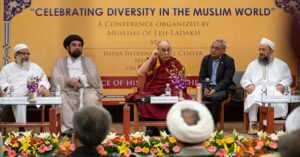His Holiness the Dalai Lama was a prominent figure at a recent meeting between Indian and other foreign Muslims. The Celebrating Diversity in the Muslim World Conference was held on June 15 in New Delhi and aimed to promote and celebrate differences within the Muslim community.
The Conference was organised by the Muslim community in Ladakh with the encouragement of His Holiness the Dalai Lama. There were around 350 people in the audience, including Hamid Ansari, the former Vice President of India, Nobel laureate and children’s rights activist Kailash Satyarthi, as well as a delegation from Iran.
His Holiness was given a warm welcome to the conference. He addressed the audience on subjects such as meditation and how to teach school children about love and compassion.
He praised the one thousand year history of religious harmony in India, with particular reference to the good relations between Shia and Sunni Muslims. He also urged Indian Muslims to encourage the rest of the world to be as tolerant of religious differences saying, “Now, it is not sufficient to have peace within the community but now the time has come to show the outside world where conflict in the name of Shia and Suni in Muslim faith is there, that peace is possible and important.”
His Holiness went on to express his dismay that “[violence] could happen between people of the same faith, who worship the same God, read the same Holy Scripture and follow the same pattern of praying five times a day”.
Earlier in the week His Holiness met a group of Iranian businessmen, self-proclaimed “messengers of peace”, known as The Iranian Impactors Club. In a similar way to the conference in New Delhi, His Holiness was warmly welcomed, gave an address to the audience and answered questions on topics which included the harassment of the Rohinga Muslims in Burma. In his address His Holiness evoked the three commitments of his life: promotion of human values, religious harmony and the Tibetan cause.
In the last census it was calculated that Muslims make up approximately 14.2% of the Indian population, making it the largest religion in India after Hinduism.






 Print
Print Email
Email